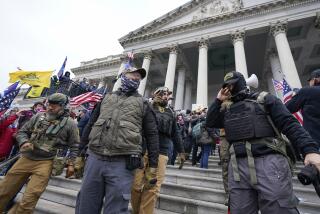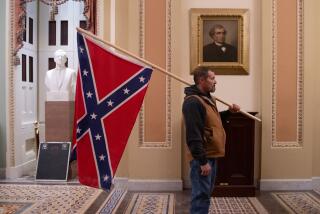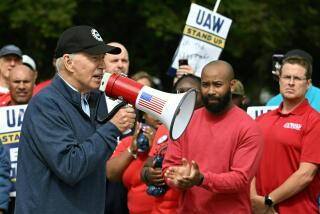Op-Ed: Woodrow Wilson’s woman problem, a case study for the Trump era
Donald Trump will not be the first president upstaged by a mass demonstration of women. The consequences depend on whether both he and modern-day feminists learn from their predecessors’ experience.
When Woodrow Wilson pulled into Washington’s Union Station the day before his inauguration 104 years ago, the massive hall echoed emptily, as did streets outside the ornate railway stop.
“Where are all the people?” the dismayed president-elect asked.
“Watching the suffrage parade,” the police replied.
Half a mile away, thousands of spectators mobbed sidewalks to witness the first peaceful civil rights demonstration in American history. Approximately 8,000 women, dressed mostly in white, paraded from the Capitol to the Treasury Department to put Wilson on notice that they expected him to change.
The most overtly anti-feminist president became the foremost proponent of universal suffrage.
A progressive supporter of labor and banking reform, Wilson nonetheless opposed women’s suffrage. Women who spoke in public gave him a “chilled, scandalized feeling,” Wilson informed his fiancee. In the 1912 presidential campaign, the Democrat told his staff that he was “definitely and irreconcilably opposed to woman suffrage,” that a “woman’s place was in the home, and the type of woman who took an active part in the suffrage agitation was totally abhorrent” to him.
Feminists despised him in return. They supported Teddy Roosevelt’s Bull Moose Party, the first to formally endorse women’s right to vote. When World War I erupted, suffragists picketed the White House with placards comparing Wilson to the hated German kaiser. The president initially tipped his hat to the protesters he found ridiculous, but eventually had them arrested and jailed.
Wilson’s reeducation began with the women’s suffrage march that preceded his inauguration. The 1913 parade featured nine bands, four mounted brigades, 20 floats, phalanxes of marchers carrying roses, a dozen foreign delegations and a climactic street performance.
For the next five years, suffrage leaders tirelessly petitioned the president, hewing strictly to a single bold demand to keep their otherwise diverse coalition intact: the vote. As president, Wilson found himself forced to meet routinely with both men and women whose views on gender equality opposed his. Feminist activism gradually changed Wilson’s thinking. In 1915, he cast his vote in New Jersey to give women the vote there, though he continued to resist a federal amendment — partly for fear of alienating Southern Democrats who did not wish to augment the pool of black voters.
World War I provided the final push. Suffrage leader Carrie Chapman Catt organized women to support the American war effort, for which Wilson was profoundly grateful. The Navy and Marines broke with tradition and enlisted more than 13,000 women, whose domestic military service freed men to go abroad. Thousands more volunteered with the Salvation Army, Red Cross and YWCA. In addition to nurses, the Army recruited 223 women who sailed to France with the U.S. Signal Corps and braved bombardment to handle telecommunications.
Wilson did an about-face. In October 1918, he asked the U.S. Senate to honor those who had served “upon the very skirts and edges of the battle itself” by ratifying the 19th Amendment. The most overtly anti-feminist president became the foremost proponent of universal suffrage.
Much as it was a century ago, the United States is at a flex point in relations between the sexes. The first woman nominated by a major party for the nation’s highest office was defeated by a man notorious for disparaging and even assaulting women.
During his campaign, Trump called female reporters pigs and dogs, downplayed sexual harassment in the workplace, suggested women be jailed for abortions, and mocked the only woman to run in the Republican primaries, Carly Fiorina. “Look at that face!” the former beauty pageant owner exclaimed. “Would anyone vote for that?” Trump’s attitude is crasser than Wilson’s, but so is our era. Likewise, Saturday’s Women’s March on Washington will no doubt be a less decorous affair than the 1913 parade.
Can Trump redeem himself? That depends on him pressuring members of his own party to support measures aimed at gender equality, as Wilson did. Can feminists help the new president? That depends on their willingness to minimize other differences and articulate a specific demand, as their predecessors did — something foundational for all women, as women, that establishes a moral and legal principle against which other laws may be measured.
There’s already infighting among march organizers over reproductive rights and identity politics. But, as it happens, there’s unifying legislation available for the taking: the Equal Rights Amendment, first introduced in 1923, to guarantee that “equality of rights under the law shall not be abridged on the basis of sex.” Congress passed the ERA in 1972, but it was never ratified by the states. Perhaps this is the time to revisit it. Earlier feminists fought 71 years to obtain the vote. The wait proved worthwhile.
Trump says his administration will be “great” for women. Let him find a suitably audacious way to show it.
Elizabeth Cobbs is the Melbern Glasscock Professor of American History at Texas A&M and the author of “The Hello Girls: America’s First Women Soldiers.”
Follow the Opinion section on Twitter @latimesopinion or Facebook
More to Read
A cure for the common opinion
Get thought-provoking perspectives with our weekly newsletter.
You may occasionally receive promotional content from the Los Angeles Times.






